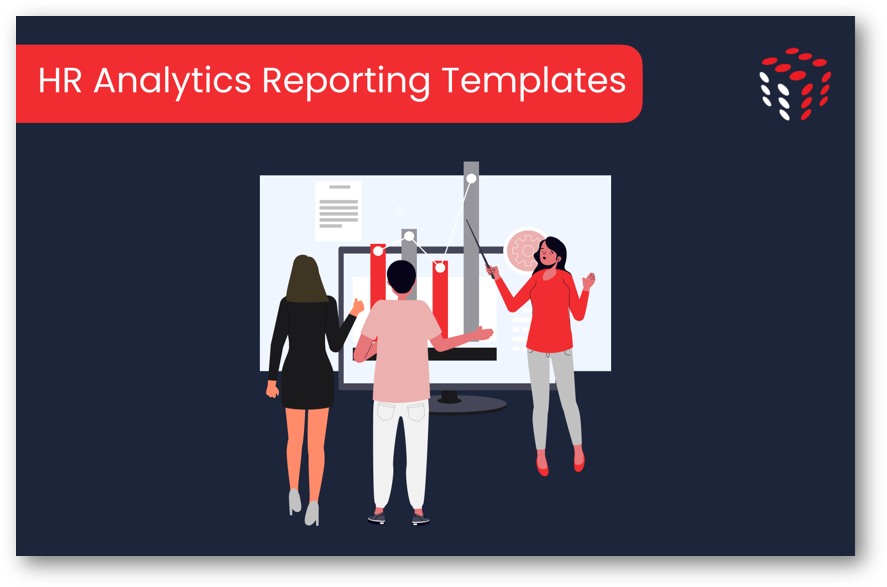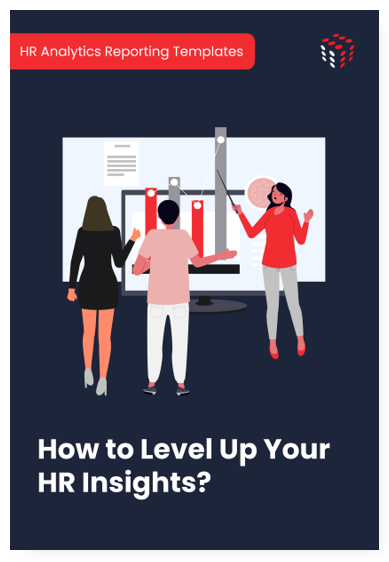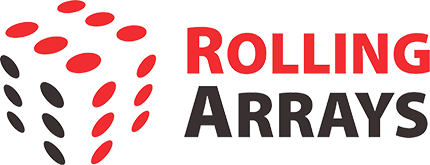
Whitepaper
Transforming HR Functions: The Impact of HR Analytics and 6 Essential KPIs
HR Analytics Reporting Templates Included


Table of Contents

HR Analytics Reporting Templates
Include templates for reporting the 6 KPIs on a monthly/quarterly basis. This gives readers sample reporting formats to customize based on their needs.
RESOURCES > WHITEPAPER > Transforming HR Functions: The Impact of HR Analytics and 6 Essential KPIs
Published on Sep 16, 2023
The Human Resources (HR) function is undergoing a transformative journey in an era of unprecedented change and digital acceleration. As the guardian of an organisation’s most valuable asset—its people—the HR department is embracing the power of analytics to drive informed, strategic decisions and foster a culture of continuous improvement. This paradigm shift from traditional, intuition-based decision-making to data-driven strategies is ushering in a new era for HR, termed HR Analytics.
At the heart of HR Analytics lies the power to distil vast amounts of data into actionable insights that can profoundly impact an organisation’s operational efficiency and bottom line. It presents opportunities to identify patterns, predict trends, and fuel more intelligent decision-making processes. However, amid a deluge of potential data points, the key to successfully leveraging HR Analytics lies in narrowing the focus to a select set of meaningful and relevant Key Performance Indicators (KPIs).
In this discourse, we delve into six essential HR KPIs that are a strong foundation for any HR Analytics endeavour: Hiring Cost per Employee, Management Cost Per Employee, Development Cost Per Employee, Attrition Rate, Experience Index, and Performance Index. Understanding these metrics, and the fundamental data and processes required for each, paves the way for successful and impactful HR Analytics.
However, before progressing to advanced analytical techniques like predictive analytics, it’s crucial to grasp these fundamentals fully. In the journey of HR Analytics, solid groundwork in understanding and tracking these KPIs ensures that your organisation is ready to embrace the power of advanced HR analytics technologies in the future.
The Six Key HR Analytics KPIs
A clear, concise set of KPIs serves as the compass guiding the implementation and interpretation of HR analytics. Let’s examine the six crucial KPIs that can provide actionable insights to enhance your organisation’s HR strategies when correctly tracked and analysed.
Hiring Cost Per Employee
This metric offers an insightful understanding of the cost of hiring a new employee, encapsulating external and internal costs related to people, systems, and third-party vendors. This KPI is essential in assessing the efficiency and effectiveness of your recruitment processes and strategies. By quantifying the cost of each new hire, this metric provides insights into the efficiency of the recruitment process and helps identify areas for improvement.
Management Cost Per Employee
The Management Cost Per Employee metric focuses on the total administrative cost associated with each employee. It includes all expenses linked to people, systems, and internal and external vendors. Understanding this KPI is pivotal in optimising management processes and increasing operational efficiency. Quantifying the cost of each new hire, this metric helps identify areas for improvement.
Development Cost Per Employee
This KPI encapsulates the total expenditure on an employee’s professional development, accounting for costs related to people, systems, and external vendors. Monitoring this metric ensures that employee development initiatives are cost-effective and provide a strong return on investment. By measuring each employee’s professional development cost, organisations can assess the effectiveness of their training programs and adapt them for a better return on investment.
Attrition Rate
The Attrition Rate is a vital KPI that showcases the percentage of employees who leave the company each year. Keeping a close eye on this metric can help organisations understand employee retention capabilities and develop strategies to enhance employee engagement and retention. The attrition rate indicates employee retention capabilities and offers insights into workforce satisfaction and organisational culture.
Experience Index
The Experience Index represents the overall satisfaction index of employees, calculated based on their responses to surveys covering various aspects of their work-life. This KPI can provide profound insights into employee engagement and morale, driving improvements in workplace culture and employee satisfaction. This index gives a comprehensive view of employee satisfaction, guiding HR policies to improve work conditions, boost morale, and increase productivity.
Performance Index
Finally, the Performance Index reflects the average performance rating of an employee, determined by their annual evaluations. This KPI is crucial in assessing overall workforce productivity and identifying areas for improvement. The Performance Index measures employee productivity and effectiveness, serving as a yardstick for individual and team performance.
These six KPIs form the backbone of HR analytics, and understanding them is a critical first step in harnessing the power of data to transform HR functions. In the subsequent sections, we will delve deeper into these KPIs, exploring their significance, the fundamental data requirements and processes needed, the current maturity level of each KPI in an organisation, and the technology required for accurate visualisation.P
How to Use Six Key HR KPIs to Transform Your HR Function
To Use These KPIs Effectively, You Need to Consider Three Aspects:
- Data: You need to have reliable and relevant data sources and processes for each KPI.
- Maturity: You need to assess the current maturity level of your HR analytics function for each KPI.
- Technology: You must invest in advanced HR analytics tools to accurately visualise each KPI.
In the following sections, we will cover these aspects in detail for each of the six KPIs, providing a comprehensive guide on how to use these KPIs to transform your HR function.
Hiring Cost Per Employee
Hiring Cost per Employee is a critical HR KPI representing the total expense of hiring a new employee, including external and internal costs associated with recruitment processes, systems, and third-party vendors. By providing a quantifiable measure of the cost-effectiveness of the recruitment process, this metric can help organisations streamline their hiring strategies and allocate resources more efficiently.
Required Data and Processes
To accurately track hiring costs, organizations should implement standardized processes to collect comprehensive recruitment expense data, including
- Documenting all costs related to job adverts, screening, interviews, background checks, onboarding, agency fees, etc.
- Recording expenses in a centralised HR analytics system as they occur.
- Appropriately categorising costs for analysis (e.g. background check expenses, relocation costs)
- Regularly auditing expense data to ensure completeness and accuracy
Evaluating Current Maturity Level
- Assessing hiring cost analysis maturity involves reviewing:
- The scope of current data collection – are all relevant costs captured?
- The accuracy and consistency of data based on audits
- Whether actionable insights are generated from the analysis
- If hiring managers use the analysis to make informed recruitment decisions
- Higher maturity is marked by solid data coverage, reliability, and strategic use of analysis.
Technology Requirements and Visualisation
- HR systems integration enable automated feeds of hiring cost data
- Dashboards provide real-time visibility into spending trends and benchmarks
- Drill-down capability allows parsing costs by position, department, etc.
- Forecasting tools model potential hiring costs based on growth plans.
Management Cost Per Employee
Management Cost per Employee is a vital HR KPI that measures the total expense of managing an existing employee, including external and internal costs associated with compensation, benefits, training, performance management, and retention. This metric can help organizations optimize their human capital investment and maximize employee productivity and satisfaction.
Required Data and Processes
To accurately calculate Management Cost per Employee, organisations must establish robust processes for collecting comprehensive data on all human capital expenses, including
- Direct compensation – salaries, bonuses, commissions, overtime
- Benefits – health insurance, retirement plans, share options
- Training and development – programmes, conferences, tuition reimbursement
- Performance management – appraisal systems, coaching, mentoring
- Retention initiatives – employee recognition, engagement surveys, wellness incentives
- A standardized system – to allocate these costs at the department, role, and individual staff member level. Regular audits of data completeness and accuracy are critical.
Evaluating Current Maturity Level
Higher maturity organisations have:
- Full coverage of all major management cost categories
- Reliable cost data verified through rigorous auditing
- Sophisticated analyses identifying cost drivers and optimisation opportunities
- Managers utilising the data to guide budgeting, workforce planning, and productivity investments
Technology Requirements and Visualization
- HRIS integrations with payroll and finance systems enable reliable cost data flows
- Interactive dashboards provide visibility into management cost trends
- Drill-down capability allows parsing costs by business unit, manager, or employee
- Scenario modelling and forecasting provides insights into the ROI of talent investments

Level Up Your HR Insights
6 Customizable KPI Report Templates for Data-Driven Decisions
The Key Benefits:
- Instant insights
- Data-driven decisions
- Customisable dashboards
- Improved HR effectiveness
Development Cost Per Employee
Development Cost Per Employee is a crucial HR KPI that measures the total cost invested in an employee’s professional development. This includes expenditures on training programs, courses, mentoring, and other development opportunities. Understanding this KPI can help HR leaders evaluate the return on investment from development initiatives, adjust strategies, and optimize resources to enhance employee performance and growth.
Required Data and Processes
- Compile comprehensive data on all development costs – course fees, training, mentoring programs, learning materials, etc.
- Establish a standardized process for collecting and categorizing cost data by development initiative
- Regularly audit and validate development cost data for accuracy and completeness
Evaluating Current Maturity Level
- Assess how extensive development cost data collection is – are all costs included?
- Evaluate accuracy of data based on rigorous auditing procedures
- Examine how insights from cost analysis inform development strategy and planning
- Determine if managers utilize data to assess development program ROI
- Higher maturity involves full data coverage, reliability, and strategic use of analysis.
Technology Requirements and Visualization
- HR systems integration enables automated development cost data feeds
- Dashboards provide visibility into development spending trends
- Drill-down allows parsing costs by program, department, or employee
- Forecasting tools model future development investment needs
Attrition Rate
The attrition rate is a key metric that measures the percentage of employees who leave an organization over a specified period of time. Tracking attrition rate allows HR teams to identify trends in employee turnover and proactively address issues leading to high attrition.
Required Data and Processes
- Maintain accurate employee records on dates of joining and leaving to calculate attrition rate
- Classify employee departures as voluntary or involuntary for better analysis
- Standardize the formula for computing attrition rate across the organization
- Set up periodic reviews of attrition data with business leaders
Evaluating Current Maturity Level
- Evaluate the completeness and accuracy of exit interview data
- Assess whether involuntary and voluntary attrition is measured separately
- Determine how well attrition rate data is integrated into workforce planning
- Identify gaps in using attrition analytics to devise retention strategies
- Higher maturity involves robust data collection, granular analysis, and strategic use of insights.
Technology Requirements and Visualization
- HRIS integration provide reliable employee life cycle data for attrition rate
- Analytics dashboards visualise trends in voluntary and involuntary turnover
- Modelling helps project future attrition rates based on historical data
- Segmentation analyses attrition by department, location, demographics etc.
- Advanced analytics can compare average attrition rates to those of high performers and average performers. These insights reveal patterns that inform strategic retention decisions.
Experience Index
The employee experience index is a metric that measures employees’ overall satisfaction and engagement within an organization. It provides insight into how employees feel about factors like work environment, culture, enablement, belonging, etc.
Required Data and Processes
- Conduct periodic surveys to gather employee feedback on experience drivers
- Include quantitative rating scales and qualitative comments
- Ensure adequate sample size and demographic representation
- Analyze results to identify priority areas for improving experience
Evaluating Current Maturity Level
- Assess survey methodology and frequency to ensure relevance
- Review whether data is segmented by department, role, or attributes
- Evaluate how insights are integrated into EX strategy and planning
- Identify gaps in closing experience feedback loops with employees
- Higher maturity involves continuous listening, granular analysis, and experience improvements.
Technology Requirements and Visualization
- Employee portal and pulse surveys provide continuous experience data
- Dashboards demonstrate key trends and variations in experience scores
- Text analytics reveal insights from open-ended survey responses
- Advanced analytics correlate experience to performance and retention
Performance Index
The employee performance index measures employees’ overall productivity and effectiveness across an organization. It provides insights into how well employees are executing goals and delivering outcomes.
Required Data and Processes
- Gather performance data through goal tracking, project metrics, and manager feedback
- Ensure rating criteria is standardised across the organisation
- Weight performance factors appropriately based on role type
- Regularly review index calculation methodology for relevance
- Analyse index trends to identify high and low performers
Evaluating Current Maturity Level
- Assess whether performance data sufficiently captures employee contributions
- Examine if index factors are tied to organizational objectives
- Determine whether managers are trained on performance evaluation
- Identify blind spots in using index to improve productivity
- Higher maturity involves comprehensive data, calibrated ratings, and strategic application of insights.
Technology Requirements and Visualization
- Performance management system provide reliable index data
- Dashboards highlight trends in performance distribution
- Drill-down analysis to parse index by department, role, or manager
- Advanced analytics predict future performance based on historical data
The Role of Advanced HR Analytics Technologies
Advanced HR analytics technologies play a pivotal role in transforming the HR function. Predictive analytics allows for accurate calculation and visualization of crucial HR KPIs and enables HR leaders to predict future trends, anticipate workforce needs, and make proactive, data-informed decisions.
Software platforms such as Visier, OneModel, Crunchr, and ChartHop have emerged as leaders in the HR analytics space. These platforms provide robust, user-friendly analytics capabilities, supporting HR departments in efficiently managing and leveraging their data.
How These Technologies Can Add Value to Each KPI
These advanced HR analytics technologies add significant value to our discussed KPIs. They allow HR teams to analyze hiring, management, and development costs per employee, leading to more effective resource allocation and strategy formulation. They enable a more comprehensive and nuanced understanding of attrition rates, facilitating better retention strategies. They can visualize and interpret complex Experience and Performance Index data, improving employee satisfaction and productivity.
Practical Examples of Advanced HR Analytics in Action
Consider a practical example where an organization using Visier has observed an uptick in its Attrition Rate KPI. The advanced predictive analytics features allow the company to identify specific departments, roles, or demographic groups with higher attrition rates and forecast future trends based on current data. With this information, HR can proactively address the underlying issues contributing to high attrition.
In another example, a firm utilizing ChartHop might leverage the Performance Index KPI to identify top performers and critical skill gaps across the organization. The firm can develop targeted talent development and succession planning strategies by integrating this data with other HR KPIs.
Conclusion
Throughout this exploration, we have discovered how HR analytics, mainly focusing on six key KPIs – Hiring Cost per Employee, Management Cost Per Employee, Development Cost Per Employee, Attrition Rate, Experience Index, and Performance Index – can significantly transform the HR function. When accurately calculated and strategically leveraged, these metrics can provide invaluable insights to HR leaders, guiding decisions impacting employee satisfaction, productivity, and overall success.
While the allure of advanced analytics capabilities like predictive analytics is strong, it’s essential first to establish a solid foundation of basic HR KPIs. Understanding the fundamental data requirements and processes, and the technology necessary for accurate visualization of each KPI, form the bedrock upon which more sophisticated analytics can be built.
As HR continues to evolve into a more strategic and data-driven function, HR analytics is no longer a nice-to-have but a must-have. Leveraging tools like Visier, OneModel, Crunchr, and ChartHop can help organizations gain an edge in today’s competitive talent market. The transformation of the HR function through analytics fosters a better understanding of the workforce and empowers HR leaders to shape a more engaging, satisfying, and productive workplace.
And with that, we conclude our journey through the transformation of HR functions via HR analytics. Becoming a genuinely data-driven HR organization is challenging but rewarding – a path worth embarking on.
About Rolling Arrays
Rolling Arrays has been driving SAP SuccessFactors-led HR Transformation since 2009. The company specialises in SF consulting, implementation, and support and also builds applications to enhance the utility of the SuccessFactors platform. It is committed to designing systems that help its customers to attract, develop and retain talented individuals. In 2021, Rolling Arrays was recognized as one of the top 75 fastest-growing companies in Singapore by The Straits Times & Statista.




Share with your network
Get updates in your inbox